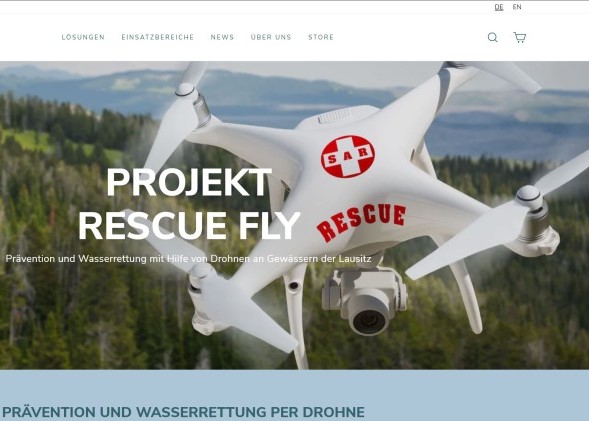Germany’s Federal Ministry of Digital Affairs and Transport (BMDV) is funding the RescueFly project launched in January 2022 to help shorten the rescue period for water rescue. Brandenburgisches Institut is hosting a public information event on 20 July 2022 to discuss the opportunities and risks of the project where the project consortium can answer questions about the use of drones and the wide range of possible applications.
Alerting and localization in emergencies in the water pose particular challenges for the rescue chain, since difficult-to-access and large-scale deployment areas require a high level of personnel and time to collect situation information. Against this background, the RescueFly research project intends to make an important technical and socio-political contribution to the development of modern and fast emergency rescue in Germany. With the use of automated drones, RescueFly expands the possibilities in water rescue and shortens the time to first aid for a person in distress.
Rescue drones: Autonomous lifeguards from the third dimension
With the help of rescue drones, people in need can usually be located better than with helicopters, boats or lifeguards, for example due to their low flight altitude and clearer lines of sight that cannot be obscured by strong waves.
In addition, drones can automatically and quickly search unguarded waters for accident victims before the rescue services arrive and forward the data to the emergency services in real time. This allows rescue workers to navigate to the casualty more quickly. The chances of survival can also be significantly extended by dropping aids such as self-triggering buoys at a precise location until the rescue services arrive.
Other advantages: Drones are much cheaper to procure than helicopters and ensure a faster response time with lower operating costs and reduced personnel requirements. Thanks to their low flight altitude, they can also be used in poor visibility conditions. Water rescue using drone support is thus becoming a valuable and at the same time complementary part of the rescue chain.
RescueFly intends to develop and deploy Unmanned Aircraft Systems (UAS) connected online to a rescue centre and equipped with adequate sensors, in modern and technically advanced drone garages
to support water rescue in areas that are difficult to access and cover large areas. A test area of application is the Lusatian lake landscape, especially the lakes Geierswalder See and Partwitzer See, which are located in the federal state of Brandenburg and the Free State of Saxony.
RescueFly develops alerting and AI elements for image recognition and flight mission optimisation.
The mission is to be simulated in a virtual environment in order to analyse and automatically optimise the location of drones and flight trajectories to the deployment points for different scenarios. The aim is to contribute to shortening the rescue time in water rescue by locating casualties on the water surface with the help of the autonomous drone and navigating rescue forces to the casualty with pinpoint accuracy.
Droniq is providing its drone traffic management system to the rescue control centres.
Find registration information here
For more information visit:




